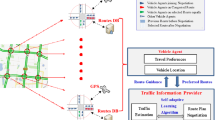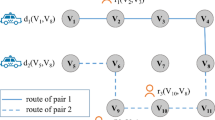Abstract
Improving the travel efficiency of citizens and the operation efficiency of urban has always been the goal of Intelligent Transportation System. Due to the neglect of strong traffic demand and driving behaviour preferences, coupled with the insufficient of communication and computing power, the existing measures based on the centralized control of vehicles or mandatory traffic restrictions lead to the traffic efficiency dramatically deviates from the system optimum. Which puts forward an urgent demand for multi-vehicle collaborative apportionment, but also brings challenges. In this paper, a double-layer collaborative apportionment method for connected vehicles, 2L-CoV for short, is proposed under the assistance of Space-air-ground integrated networks. 2L-CoV includes the traffic flow scheduling in global-layer and the vehicle routing planning in local-layer. Firstly, a distributed collaborative framework based SAGIN is presented to make a large-scale of virtual vehicles can interact with each other. Then, at the global-layer, traffic flow is guided speedily by an improved back-pressure algorithm to complete traffic flow scheduling; at the local-layer, considering the driving behaviour preferences, a game evolution online learning approach based on dominant strategy is proposed to plan the vehicle routing. Finally, the simulation results show that 2L-CoV can effectively balance the traffic network, improves the network throughput, and reduces the total travel time.







Similar content being viewed by others
References
Yamashita T, Izumi K, Kurumatani K (2004) Car navigation with route information sharing for improvement of traffic efficiency. In: Proceedings. The 7th international ieee conference on intelligent transportation systems. IEEE, pp 465–470
Adler JL, Blue VJ (2002) A cooperative multi-agent transportation management and route guidance system. Transp Res C Emerg Technol 10(5-6):433–454
Eydi A, Panahi S, iNakhai Kamalabadi I (2017) User-based vehicle route guidance in urban networks based on intelligent multi agents systems and the ant-q algorithm. Int J Transp Eng 4(3):147–161
Li J, Fu D, Yuan Q, Zhang H, Chen K, Yang S, Yang F (2019) A traffic prediction enabled double rewarded value iteration network for route planning. IEEE Trans Veh Technol 68(5):4170– 4181
Messmer A, Papageorgiou M (1990) Metanet: a macroscopic simulation program for motorway networks. Traffic Eng Control 31(8):466–470
Groot N, Zaccour G, Schutter BD (2017) Hierarchical game theory for system-optimal control: applications of reverse stackelberg games in regulating marketing channels and traffic routing. Control Syst IEEE 37(2):129–152
Jing A (2009) Route guidance strategy simulation based on multi-agent game approach. Int J Transp Saf 3
SS VC et al (2020) A multi-agent ant colony optimization algorithm for effective vehicular traffic management. In: International conference on swarm intelligence. Springer, pp 640–647
Luo G, Zhang H, He H, Li J, Wang FY (2020) Multiagent adversarial collaborative learning via mean-field theory. IEEE Trans Cybern :1–14
Yuan Q, Li J, Zhou H, Lin T, Luo G, Shen X (2020) A joint service migration and mobility optimization approach for vehicular edge computing. IEEE Trans Veh Technol 69(8):9041–9052
Li G, He B, Du A (2018) A traffic congestion aware vehicle-to-vehicle communication framework based on voronoi diagram and information granularity. Peer Peer Netw Appl 11(1):124–138
Lyu F, Wu F, Zhang Y, Xin J, Zhu X (2020) Virtualized and micro services provisioning in space-air-ground integrated networks. IEEE Wirel Commun 27(6):68–74
Osborne MJ, Rubinstein A (1994) A course in game theory. MIT press, Cambridge
Wang M, Shan H, Lu R, Zhang R, Shen X, Bai F (2015) Real-time path planning based on hybrid-vanet-enhanced transportation system. IEEE Trans Veh Technol 64(5):1664–1678
Xiong X, Wang J, Zhang F, Li K (2016) Combining deep reinforcement learning and safety based control for autonomous driving. arXiv:1612.00147
Nazari M, Oroojlooy A, Snyder LV, Takáč M (2018) Reinforcement learning for solving the vehicle routing problem. arXiv:1802.04240
Lyu F, Cheng N, Zhu H, Zhou H, Xu W, Li M, Shen X (2020) Towards rear-end collision avoidance: adaptive beaconing for connected vehicles. IEEE Trans Intell Transp Syst
Yang S, Li J, Wang J, Liu Z, Yang F (2018) Learning urban navigation via value iteration network. In: 2018 IEEE intelligent vehicles symposium (IV). IEEE, pp 800–805
Brahmbhatt S, Hays J (2017) Deepnav: Learning to navigate large cities. In: Proceedings of the IEEE conference on computer vision and pattern recognition, pp 5193–5202
Marin-Plaza P, Hussein A, Martin D, de la Escalera A (2018) Global and local path planning study in a ros-based research platform for autonomous vehicles. J Adv Transp 2018(PT. 1):1–10
Klein I, Levy N, Ben-Elia E (2018) An agent-based model of the emergence of cooperation and a fair and stable system optimum using atis on a simple road network. Transp Res C Emerg Technol 86:183–201
Torabi B, Wenkstern RZ, Saylor R (2020) A collaborative agent-based traffic signal system for highly dynamic traffic conditions. Auton Agent Multi-Agent Syst 34(1):1–24
Zaidi AA, Kulcsár B, Wymeersch H (2016) Back-pressure traffic signal control with fixed and adaptive routing for urban vehicular networks. IEEE Trans Intell Transp Syst 17(8):2134–2143
Zhu B, Li J, Yuan Q, Lu J, Yang S (2019) An edge-assisted vehicle routing method based on game-theoretic multiagent learning. In: 2019 IEEE 25th international conference on parallel and distributed systems (ICPADS). IEEE, pp 462–469
Neely MJ, Urgaonkar R (2009) Optimal backpressure routing for wireless networks with multi-receiver diversity. Ad Hoc Netw 7(5):862–881
Acknowledgment
This work is supported by the Natural Science Foundation of China under Grant 61876023 and Grant 61902035.
Author information
Authors and Affiliations
Corresponding author
Additional information
Publisher’s note
Springer Nature remains neutral with regard to jurisdictional claims in published maps and institutional affiliations.
This article belongs to the Topical Collection: Special Issue on Space-Air-Ground Integrated Networks for Future IoT: Architecture, Management, Service and Performance Guest Editors: Feng Lyu, Wenchao Xu, Quan Yuan, and Katsuya Suto
Rights and permissions
About this article
Cite this article
Wei, X., Han, X., Zhu, B. et al. A double-layer collaborative apportionment method for personalized and balanced routing. Peer-to-Peer Netw. Appl. 14, 3349–3359 (2021). https://doi.org/10.1007/s12083-021-01136-z
Received:
Accepted:
Published:
Issue Date:
DOI: https://doi.org/10.1007/s12083-021-01136-z




